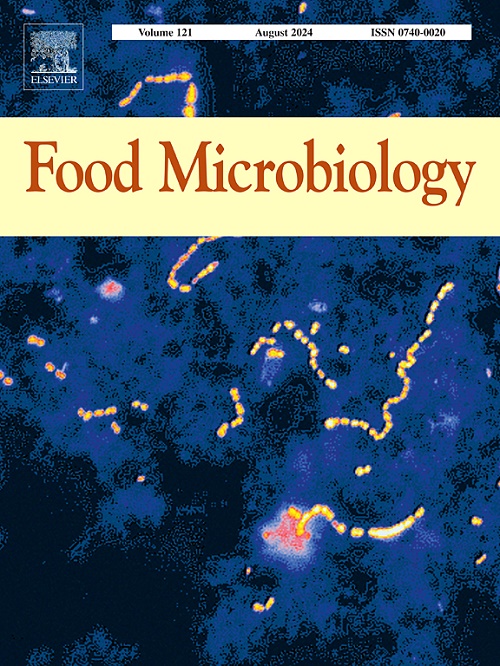The habituation to different concentrations of salt may variably influence the ability of Cronobacter sakazakii, Salmonella enterica serovar Enteritidis, Bacillus cereus, and Staphylococcus aureus to resist acid, bile salt, and heat stresses
IF 4.5
1区 农林科学
Q1 BIOTECHNOLOGY & APPLIED MICROBIOLOGY
引用次数: 0
Abstract
This study was to examine the relationship between preexposure to salt and stress-responsive resistance to acid, bile salt, and heat in Cronobacter sakazakii, Salmonella enterica serovar Enteritidis, Bacillus cereus, and Staphylococcus aureus. Stationary phase-grown cultures of C. sakazakii, S. Enteritidis, B. cereus or St. aureus were subjected to elevated concentrations of salt (maximally 14.0%), and the cells of each bacterium were allowed to grow at 37 °C for consecutive 6 d. The 6-d habituated cells were then subjected to acid (pH 2.0), 10% bile salt, and heat (60 °C) stresses. C. sakazakii, S. Enteritidis, and St. aureus were more sensitive to acid after the habituation process than their stationary phase-grown counterparts. Although the 0.5% salt-habituated cells of B. cereus better survived at a subsequent acid challenge than did the nonhabituated cells of this bacterium, there were no significant (p 0.05) differences in the Gompertz-derived growth kinetics between salt-habituated and nonhabituated cultures. Similarly, C. sakazakii and S. Enteritidis cells preexposed to salt was far more heat-sensitive, whereas the preexposure of B. cereus and St. aureus to 0.5 and 8.0% salt, respectively, resulted in their increased survival against heat as compared with their nonhabituated control. Nevertheless, the resultant growth parameters revealed that salt has no clear inducive effect on the acquisition of resistance responses to heterogeneous stresses. Overall, the habituation to different concentrations of salt may variably influence the ability of C. sakazakii, S. Enteritidis, B. cereus, and St. aureus to resist acid, bile salt, and heat stresses.
求助全文
约1分钟内获得全文
求助全文
来源期刊

Food microbiology
工程技术-生物工程与应用微生物
CiteScore
11.30
自引率
3.80%
发文量
179
审稿时长
44 days
期刊介绍:
Food Microbiology publishes original research articles, short communications, review papers, letters, news items and book reviews dealing with all aspects of the microbiology of foods. The editors aim to publish manuscripts of the highest quality which are both relevant and applicable to the broad field covered by the journal. Studies must be novel, have a clear connection to food microbiology, and be of general interest to the international community of food microbiologists. The editors make every effort to ensure rapid and fair reviews, resulting in timely publication of accepted manuscripts.
 求助内容:
求助内容: 应助结果提醒方式:
应助结果提醒方式:


